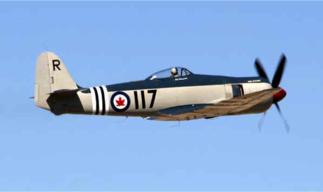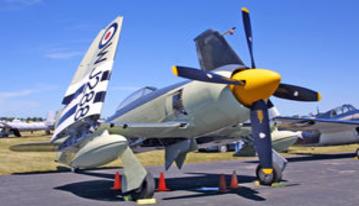Gallery No 24 - Hawker Sea Fury
Aircraft - 2Images
My thanks to Roger Dunn and the MOD for supplying these images.Wikipedia for text.
| The Hawker Fury was an evolutionary successor
to the successful Hawker Typhoon and Tempest fighters and fighter-bombers
of the Second World War. The Fury was designed in 1942 by Sidney Camm,
the famous Hawker designer, to meet the RAF's requirement for a lightweight
Tempest II replacement.
A Sea Fury in the Royal Navy Colors, Oshkosh, 2003.In 1943 the design was modified to meet a Royal Navy request for a carrier-based fighter. Boulton-Paul Aircraft were to make the conversion while Hawker continued work on the Air Force design. The first Sea Fury prototype flew on February 21, 1945, and was powered by a Bristol Centaurus XII; it had a tailhook for arrested carrier landings, but lacked folding wings. The second prototype was powered by a Centaurus XV and did have folding wings, and the prototypes were undergoing carrier landing trials when the Japanese surrendered in 1945. The end of the war also ended development of the land-based Fury, although the Royal Navy only reduced the number of aircraft in their contract to 100 and cancelled the Boulton-Paul agreement. General characteristics Wingspan: 38 ft 4 3/4 in (11.7 m) Speed: 460 mph (740 km/h) Guns: Four 20 mm cannon
|
Some aircraft may appear identical but there are differences which will not be discernible from the image.
(Be patient with loading)
 |
Sea Fury of the RCAF |
 |
A Sea Fury in the Royal Navy Colors, Oshkosh, 2003. |
(Be patient with loading)